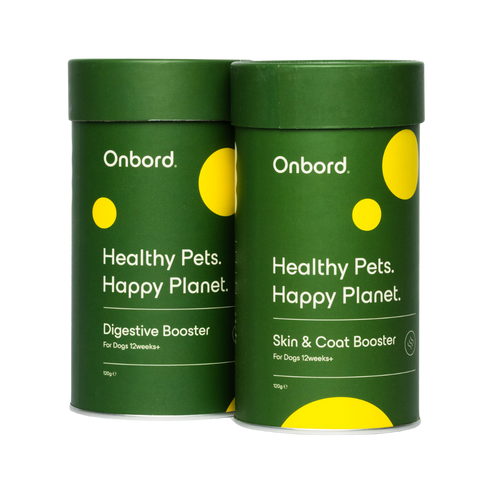The Ultimate Cosy Dog Area Ideas: Options for Homes of All Sizes
Designing a dog-friendly area is an essential part of ensuring your pet’s comfort, happiness, and health. Whether you live in a spacious house with plenty of room or a cosy flat where space is at a premium, you can create a dedicated area that meets your dog’s needs. With practical tips and insights backed by veterinary research, this guide will help you create a dog area that supports their well-being, no matter your living situation. You need some ideas for your dog's area and we are here to help you! 
What You’ll Learn from This Guide:
- The importance of a dedicated space for your dog’s well-being and comfort.
- How cultural concepts like hygge, lagom, and feng shui can inspire a cosy, positive space.
- Five essentials for a dog-friendly area, including bedding, feeding stations, toys, ventilation, and relaxation spaces.
- Tips for creating a functional dog area in both large homes and cosy flats.
- Practical ideas for paw-friendly flooring, hydration stations, and space-saving storage.
- Ways to personalise and maintain a clean, healthy space for your pet.
- How to design a retreat that reduces stress and encourages your dog’s happiness and health.
Why Your Dog Needs Their Own Space
A designated area for your dog isn’t just a convenience—it’s a vital part of their well-being. Dogs thrive when they have a secure and comfortable retreat to relax and feel safe. Veterinary research shows that providing a specific space for your dog helps reduce stress, supports better sleep, and encourages healthy habits. The key is to design an area that caters to their needs while fitting seamlessly into your home, whether it’s large or small.
Creating a Cosy Space for Your Dog: Comfort and Positive Energy
Before diving into the essentials of a dog-friendly area, it’s important to think about the overall atmosphere you’re creating. A cosy space isn’t just about physical comfort; it’s about creating an environment where your dog feels safe, relaxed, and truly at home. Many cultures around the world have concepts tied to comfort, warmth, and well-being that can inspire your design.
Cosiness Across Cultures
- Hygge (Denmark): This Danish concept focuses on creating a sense of warmth and contentment. A hygge-inspired dog space could include soft textures, warm lighting, and calming scents to evoke comfort.
- Lagom (Sweden): Translating to "just the right amount," this Swedish idea of balance and moderation can guide you in designing a dog area that isn’t cluttered but has everything your pet needs.
- Wabi-Sabi (Japan): This philosophy embraces simplicity and the beauty of imperfection. For your dog’s space, this might mean using natural materials and embracing a minimalist, calming design.
The Role of Feng Shui in Your Dog’s Area
Feng shui, the ancient Chinese practice of harmonising energy within a space, can also be applied to your pet’s area. Dogs are highly sensitive to their surroundings and can pick up on both positive and negative energies.
- Placement Matters: Position your dog’s space in a quiet but central area where they can feel connected to the household without being overwhelmed. Avoid high-traffic spots or areas near loud appliances.
- Use Natural Elements: Incorporate calming natural elements like wood or plants (ensuring they’re pet-safe). These create a grounding effect, helping your dog feel more secure.
- Energy Flow: Keep the space tidy and free of clutter. A cluttered area can create a sense of chaos and stress for your dog.
By combining these cultural principles, you can create a cosy, positive-energy space where your dog feels calm and loved. Once this foundational atmosphere is in place, you can move on to adding the key essentials for their health and happiness.
Essentials to inspire you for Your Dog Area Ideas: Customisable for Any Home
1. Comfortable and Supportive Bedding
A soft, supportive bed is a must-have for any dog area, giving your pet a comfortable place to rest and recharge.
- For Larger Spaces: Choose a spacious bed that allows your dog to stretch out fully. Consider adding a cosy blanket or cushion for extra comfort. For multi-dog households, multiple beds or a shared oversized bed can keep everyone happy.
- For Smaller Spaces: Look for compact, space-saving options like beds that fit into corners, under furniture, or inside crates. Consider foldable or roll-up beds for versatility.
- Why It Matters: Comfortable bedding reduces stress on joints and provides a sense of security. Orthopaedic beds are particularly beneficial for older dogs or large breeds prone to joint issues.
2. A Designated Feeding Station
A clean and organised feeding area helps maintain hygiene and creates a routine for your dog.
- For Larger Spaces: Set up a dedicated feeding corner with elevated bowls and a mat to catch spills. Consider adding storage nearby for food, treats, and feeding accessories.
- For Smaller Spaces: Use stackable or collapsible bowls and a small mat to keep things tidy. Wall-mounted shelves or under-counter storage can hold food and supplies efficiently.
- Why It Matters: A specific feeding station keeps your home tidy and supports your dog’s digestion, particularly if elevated bowls are used for larger breeds.
3. Toys for Mental Stimulation and Enrichment
Mental enrichment is just as important as physical exercise for your dog’s health and happiness.
- For Larger Spaces: Create a play zone with a variety of toys, such as puzzle feeders, chew toys, and plush companions. Use storage bins or baskets to keep the area organised.
- For Smaller Spaces: Focus on multi-purpose toys that provide both mental and physical stimulation, like treat-dispensing balls or collapsible puzzles. Rotate toys to keep your dog engaged without taking up too much space.
- Why It Matters: Toys prevent boredom and destructive behaviour while supporting cognitive development. They also provide a fun way for you to bond with your pet.
4. Proper Ventilation and Lighting
The environment of your dog’s area significantly impacts their physical and emotional health.
- For Larger Spaces: Position the area near a window for natural light and fresh air. If the space allows, consider adding a dog flap to an outdoor area for easy access to fresh air and exercise.
- For Smaller Spaces: Choose a well-lit corner of the room or use artificial lighting if natural light isn’t an option. A small fan or air purifier can improve ventilation in compact spaces.
- Why It Matters: Proper ventilation keeps the area fresh and free from odours, while natural light supports your dog’s circadian rhythm, improving their sleep and mood.
5. A Safe, Enclosed Space for Relaxation
Dogs need a quiet, secure space to retreat, especially during stressful situations like loud gatherings or storms.
- For Larger Spaces: Use a playpen or dedicate an entire room to your dog. Add cosy bedding, toys, and calming elements like a blanket with your scent or a white noise machine.
- For Smaller Spaces: A crate or a gated-off section in a corner can serve as a perfect retreat. Look for multi-functional furniture, like a dog crate that doubles as an end table, to save space.
- Why It Matters: A safe space helps reduce anxiety and gives your dog a sense of control over their environment. It’s particularly important for puppies, rescue dogs, or those prone to nervousness.
Additional Tips for Homes Big and Small
- Paw-Friendly Flooring: For those needing dog joint care. Add rugs or rubber mats to slippery floors, preventing injuries and improving comfort. For smaller spaces, a simple mat under your dog’s area can make a big difference.
- Hydration Station: Ensure your dog always has access to fresh water. Use spill-proof bowls for active dogs or self-refilling options if space permits.
- Storage Solutions: Keep your dog’s supplies organised with space-conscious storage options like bins, wall-mounted hooks, or multi-functional furniture.
- Personalisation: Add personal touches like a name plaque, photos, or their favourite blanket to make the space uniquely theirs.
-
Regular Cleaning: No matter the size of your home, maintaining cleanliness is crucial. Wash bedding regularly, vacuum the area, and sanitise food and water bowls to keep your dog healthy.
- Storage for their: hygiene items, shampoo, vitamins, toys & maybe even their vet documents, you don't want to have to be scratching around for them when you need them.
Conclusion: Tailoring the Perfect Dog Area for Your Home
Whether you have a sprawling house with plenty of space or a cosy flat with limited room, creating a dedicated dog area is achievable and beneficial. By incorporating essentials like comfortable bedding, a feeding station, and mental enrichment toys, you’ll design a space that supports your dog’s health, happiness, and well-being. With thoughtful planning and creative use of space, your dog will have a cosy retreat they can call their own.
A happy dog makes for a happy home—no matter its size.





